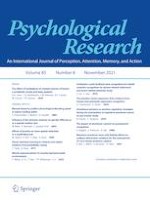25-11-2020 | Original Article
Influence of the stimulus material on gender differences in a mental-rotation test
Gepubliceerd in: Psychological Research | Uitgave 8/2021
Log in om toegang te krijgenAbstract
Gender differences in mental-rotation tests with cube figures as rotational material are well examined and robust. Besides biological or socialization factors, task characteristics could partly be responsible for men’s advantage in mental rotation. Therefore, we investigated in two studies the influence of different rotational materials on the gender differences in mental-rotation performance. In the first study, 134 undergraduate students (89 women, 45 men) participated using a mental-rotation test with either cube or pellet figures. Significant gender differences in favour of men but no interaction of gender and material were found. In the second study, 189 undergraduate students (110 women, 79 men) solved a mental-rotation test with either male or female-stereotyped objects. Significant gender differences appeared only when male-stereotyped objects were used as rotational material, but not for female-stereotyped material. A significant interaction of gender and material appeared. Hence, some rotational objects seem to have an influence on participants’ mental-rotation performance and the gender differences in this task while others do not affect performances of women and men.
